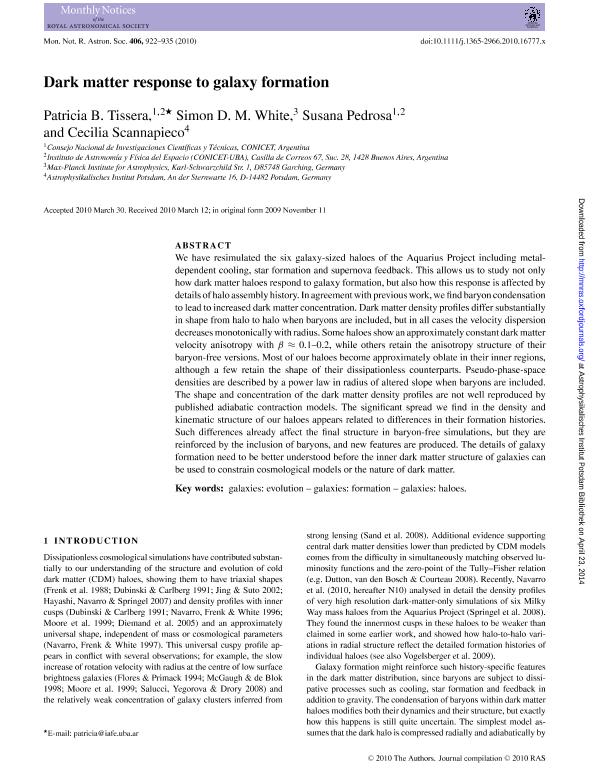Mostrar el registro sencillo del ítem
dc.contributor.author
Tissera, Patricia Beatriz

dc.contributor.author
White, Simon D.M.
dc.contributor.author
Pedrosa, Susana Elizabeth

dc.contributor.author
Scannapieco, Cecilia

dc.date.available
2017-07-13T21:26:50Z
dc.date.issued
2010-08
dc.identifier.citation
Tissera, Patricia Beatriz; White, Simon D.M.; Pedrosa, Susana Elizabeth; Scannapieco, Cecilia; Dark matter response to galaxy formation; Wiley Blackwell Publishing, Inc; Monthly Notices of the Royal Astronomical Society; 406; 2; 8-2010; 922-935
dc.identifier.issn
0035-8711
dc.identifier.uri
http://hdl.handle.net/11336/20459
dc.description.abstract
We have resimulated the six galaxy-sized haloes of the Aquarius Project including metaldependent cooling, star formation and supernova feedback. This allows us to study not only how dark matter haloes respond to galaxy formation, but also how this response is affected by details of halo assembly history. In agreement with previous work, we find baryon condensation to lead to increased dark matter concentration. Dark matter density profiles differ substantially in shape from halo to halo when baryons are included, but in all cases the velocity dispersion decreases monotonically with radius. Some haloes show an approximately constant dark matter velocity anisotropy with β ≈ 0.1–0.2, while others retain the anisotropy structure of their baryon-free versions. Most of our haloes become approximately oblate in their inner regions, although a few retain the shape of their dissipationless counterparts. Pseudo-phase-space densities are described by a power law in radius of altered slope when baryons are included. The shape and concentration of the dark matter density profiles are not well reproduced by published adiabatic contraction models. The significant spread we find in the density and kinematic structure of our haloes appears related to differences in their formation histories.
Such differences already affect the final structure in baryon-free simulations, but they are reinforced by the inclusion of baryons, and new features are produced. The details of galaxy formation need to be better understood before the inner dark matter structure of galaxies can be used to constrain cosmological models or the nature of dark matter.
dc.format
application/pdf
dc.language.iso
eng
dc.publisher
Wiley Blackwell Publishing, Inc

dc.rights
info:eu-repo/semantics/openAccess
dc.rights.uri
https://creativecommons.org/licenses/by-nc-sa/2.5/ar/
dc.subject
Galaxies:Evolution
dc.subject
Galaxies:Formation
dc.subject
Galaxies:Haloes
dc.subject.classification
Astronomía

dc.subject.classification
Ciencias Físicas

dc.subject.classification
CIENCIAS NATURALES Y EXACTAS

dc.title
Dark matter response to galaxy formation
dc.type
info:eu-repo/semantics/article
dc.type
info:ar-repo/semantics/artículo
dc.type
info:eu-repo/semantics/publishedVersion
dc.date.updated
2017-07-13T14:04:00Z
dc.journal.volume
406
dc.journal.number
2
dc.journal.pagination
922-935
dc.journal.pais
Reino Unido

dc.journal.ciudad
Londres
dc.description.fil
Fil: Tissera, Patricia Beatriz. Consejo Nacional de Investigaciónes Científicas y Técnicas. Oficina de Coordinación Administrativa Ciudad Universitaria. Instituto de Astronomía y Física del Espacio. - Universidad de Buenos Aires. Facultad de Ciencias Exactas y Naturales. Instituto de Astronomía y Física del Espacio; Argentina
dc.description.fil
Fil: White, Simon D.M.. Gobierno de la Republica Federal de Alemania. Max Planck Institut Fur Astrophysik; Alemania
dc.description.fil
Fil: Pedrosa, Susana Elizabeth. Consejo Nacional de Investigaciónes Científicas y Técnicas. Oficina de Coordinación Administrativa Ciudad Universitaria. Instituto de Astronomía y Física del Espacio. - Universidad de Buenos Aires. Facultad de Ciencias Exactas y Naturales. Instituto de Astronomía y Física del Espacio; Argentina
dc.description.fil
Fil: Scannapieco, Cecilia. Leibniz Institut Fur Astrophysik Potsdam; Alemania. Consejo Nacional de Investigaciónes Científicas y Técnicas. Oficina de Coordinación Administrativa Ciudad Universitaria. Instituto de Astronomía y Física del Espacio. - Universidad de Buenos Aires. Facultad de Ciencias Exactas y Naturales. Instituto de Astronomía y Física del Espacio; Argentina
dc.journal.title
Monthly Notices of the Royal Astronomical Society

dc.relation.alternativeid
info:eu-repo/semantics/altIdentifier/url/http://mnras.oxfordjournals.org/content/406/2/922
dc.relation.alternativeid
info:eu-repo/semantics/altIdentifier/doi/http://dx.doi.org/10.1111/j.1365-2966.2010.16777.x
dc.relation.alternativeid
info:eu-repo/semantics/altIdentifier/url/https://arxiv.org/abs/0911.2316
Archivos asociados
